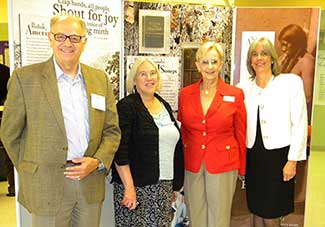New Harmonies Exhibit Comes to an End
From April 14, 2012, through November 26, 2013, the Smithsonian Institution’s New Harmonies Exhibit made stops in twelve towns highlighting the rich heritage of Georgia roots music—from gospel to rock, from blues to bluegrass. In each town the interactive exhibit was open to the public for six weeks and held in conjunction with multiple concerts featuring local artists.

GHC President Jamil Zainaldin, Ann McCleary, Georgia First Lady Sandra Deal, and Carol Harsh of the Smithsonian Institution at the New Harmonies debut in Calhoun.
On Saturday, January 18, New Harmonies moved from small-town Georgia to the Woodruff Arts Center in Atlanta where a day-long Georgia Roots Music Festival featured performers as diverse as The McIntosh County Shouters (a family that preserves and teaches a sacred tradition of slave songs and dance), Mudcat (internationally known, Atlanta-based blues artist), and The Skillet Lickers (a Bluegrass and String Music band whose origins reach back to the 1920s). In the evening the venue shifted from the Rich Theater to Symphony Hall where Chuck Leavell, Greg Allman, and others performed. Leavell’s wife, Rose Lane White Leavell, served as chair of New Harmonies. First Lady Sandra Deal was Honorary Chair.
Key to the extraordinary success of this twenty-one month project was the work of the faculty and students of UWG’s Center for Public History. Center Director Dr. Ann McCleary served as the project’s state scholar. Dr. Keith Hebert worked with the Haralson County Chamber of Commerce to coordinate the Bremen site, where last year more than 22,000 people (more than any other site) visited the exhibit at the Warren P. Sewell Memorial Library.
The experience also provided rich training for a number of UWG students. Stephen Briggs, Dustin Klein, Mollie Marlow, Bobby Moore, Sarah Foreman Reeves, and Jared Wright all worked on the project as researchers, installers, and workshop leaders. They also created the program catalog and website. Wright, who organized a demonstration of Shape Note Singing for the Woodruff Arts Center Festival, has accepted a position as Archivist for the Allman Brothers Museum in Macon. Reeves has moved on to take a position as Public Programs Coordinator for the Atlanta History Center.
Other Georgia partners in the exhibit included the Atlanta Symphony Orchestra, the Georgia Council for the Arts, and the Georgia Humanities Council. The latter funded much of the student work, and GHC President Jamil Zainaldin and I have agreed to a multi-year partnership that will engage UWG faculty and students from several programs in projects that have the potential for similar state-wide impact.
I visited the exhibit three times—when it debuted in Calhoun, when it opened in Bremen, and finally when it moved to Atlanta. There was plenty of excitement and energy around the first two, but something of the total impact of the project came home as I spoke in the Woodruff Arts Center with people from Calhoun, Perry, Darien, etc., about the tremendous impact the exhibit had on their communities, in some instances a year or more after the event. There was something else, too. We speak often in higher education, sometimes mechanically, about the value of diversity and inclusiveness. Sitting in the Rich Theater listening to act after act, many of which preserve traditions deeply rooted in race, region, even class, and they wouldn’t exist without those ties, but here they were in each case being experienced by Georgians of all backgrounds, and obviously with joy.
Congratulations to Drs. McCleary and Hebert and to their students. They did us proud!
Randy Hendricks, Ph.D. is the dean of the College of Arts and Humanities.
